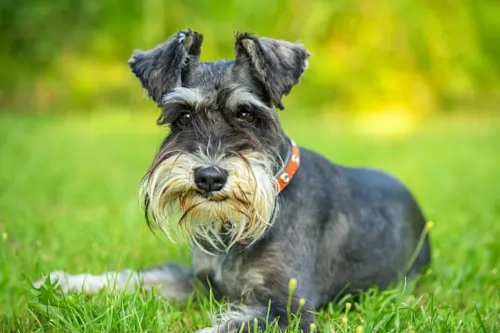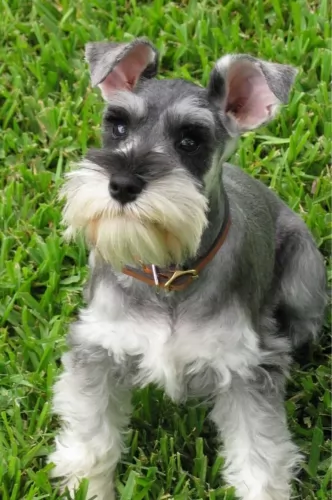 MyDogBreeds
MyDogBreedsSchnauzer is originated from Germany but Russian Setter is originated from Russia. Schnauzer may grow 17 cm / 6 inches shorter than Russian Setter. Schnauzer may weigh 12 kg / 26 pounds lesser than Russian Setter. Both Schnauzer and Russian Setter has almost same life span. Both Schnauzer and Russian Setter has same litter size. Both Schnauzer and Russian Setter requires Moderate maintenance.
 These dogs hail from Germany and are particularly well known for their stern faces and their facial hair - the mustache and eyebrows. You get 3 types of Schnauzer – the Miniature, Standard and Giant.
These dogs hail from Germany and are particularly well known for their stern faces and their facial hair - the mustache and eyebrows. You get 3 types of Schnauzer – the Miniature, Standard and Giant.
These dogs have always been used for their rat catching skills. The Standard Schnauzer is also known as Mittelschnauzer and they have been categorized as working dogs but also as Terriers.
They've always been good herders of livestock and have been regarded as a good all-round farm dog. Most Standard Schnauzers have earned American Kennel Club (AKC) herding titles. They also make excellent watchdogs.
A breed standard for this dog was written in 1880. Also, the Bavarian Schnauzer Klub was formed in Munich in 1907.
People often think it is ridiculous that a Setter dog comes from Russia. It is believed that the Russians did have some kind of Griffon and the word Pointer is also often translated as Setter.
It is believed that the Russian Setter is one of the ancestors of the Wire-haired Pointing Griffon and that it possibly shared an ancestry with the German wire-haired and broken-haired pointers.
References to Russian Setters were fairly common in the 19th century, but there is such contradictory information that it is hard to get good information on the dogs. The Russian Setter is believed to have existed before the Russian Revolution resembling the English Setter. Dog experts tell us the dog no longer exists.
 You get the miniature and giant Schnauzer as well as the Standard. The Standard Schnauzer stands at between 43 to 51cm and weighs between 14 and 20kg. The dog comes in different color variants - black, black and silver and a greyish color.They have wiry coats that don’t shed much.
You get the miniature and giant Schnauzer as well as the Standard. The Standard Schnauzer stands at between 43 to 51cm and weighs between 14 and 20kg. The dog comes in different color variants - black, black and silver and a greyish color.They have wiry coats that don’t shed much.
They are squarely and robustly built and a typical feature is the mustache, beard and significant eyebrows of the dog. The ears are set high and were once clipped but they are left floppy these days.
The tail has always been traditionally cropped to around three vertebrae,giving the dog a distinctive look, but now it is often left as is and is medium length and curls over the dog’s back.
The Schnauzie is a seriously intelligent dog and this makes them highly trainable so that he can obey quite a few commands. These dogs get bored easily and will require exercise and games that will stimulate him mentally and physically.
They’re alert too, and will bark in warning at any intruders, making them excellent watchdogs. Other notable characteristics are courage and stamina and they have been used for search and rescue work.
These dogs have strong personalities, and are inclined to be stubborn so you want to be sure that they are trained and socialized. This makes them more amicable to be around – they’re obedient and know their place.
In terms of appearance, it was John Henry Walsh who said that the Russian Setter was a dog hidden by its long, woolly matted coat.It seems to have been a medium sized dog with an elegant appearance. It seems the dog came in two varieties - the curly coated liver coated dogs and the fawn colored dogs which are straight coated.
Because there is very little information on these dogs, we assume they were between 57 – 68cm in height and between 27 and 32kg in weight. The coat was no doubt in colours such as grey, reddish-brown with some black and white and shortish and wiry. The ears were floppy,and the face no doubt had some longer hair around the muzzle.
Nobody seems to know exactly what the temperament of this dog was, but when you look at some of his ancestors you can assume that he was strong-willed, confident and a skilled hunter.
He would have required a lot of exercise too. He was lively and energetic. Because he had Pointer in him you can be sure that he would have been intelligent so that he could be trained and socialized.
He would have been keen to learn with an owner who was firm and consistent in his treatment of him. He is a dog most happiest when he can spend time with his human family, a most loyal and devoted family friend, capable of getting on well with children and pets in the home.
 Energetic, strong-willed and loyal, the Schnauzer can be an affectionate friend for children in the home as well as adults.
Energetic, strong-willed and loyal, the Schnauzer can be an affectionate friend for children in the home as well as adults.
He is cool towards strangers and he is also a bit snooty and aggressive with other dogs, but if he is brought up with them, he will show some loyalty and friendship towards them too.
It appears, according to records that the Russian Setter has come and gone. However he would have been a calm, gentle pet with running ad hunting keeping him happy. He would therefore have required a lot of exercise.
We can assume that according to the few records that there are, that this was an affable, pleasing dog breed which made a great family pet.
 Schnauzers are very healthy dogs. Nonetheless even these dogs can succumb to some of the many dog illnesses there are.
Schnauzers are very healthy dogs. Nonetheless even these dogs can succumb to some of the many dog illnesses there are.
Hip dysplasia is a common dog ailment and the Schnauzer isn’t immune to it. Hip dysplasia can be very sad in dogs as it can cripple a dog, with painful arthritis being his lot as well. It is no comfort for dog owners to know that hip dysplasia is common in most dog breeds – they are devastated when their once playful dog is brought down by hip dysplasia and exhibits signs of stiffness and pain.
The Russian Setter had an average lifespan of 10 – 14 which is a fairly good innings for a dog. Nonetheless you would have had to be aware of some common dog problem. These dogs were prone to major health issues such as both hip and elbow dysplasia, deafness, epilepsy and hypothyroidism.
The thyroid glands produce hormones that affect the function of many parts of the body. Dogs with this illness have a low production of thyroid hormones.
This disease is mainly caused by inflammation or shrinkage of the thyroid gland. The most common signs of low thyroid in dogs is thinning of the fur, the coat is dull, there is weight gain and excess shedding. The dog doesn’t tolerate cold well either. These dogs also often have ear infections.
 Your Schnauzer will need to have his hair brushed twice a week as well as being professionally groomed. This is by hand-stripping or by clipping.
Your Schnauzer will need to have his hair brushed twice a week as well as being professionally groomed. This is by hand-stripping or by clipping.
Standard Schnauzers have lots of energy and will require adequate exercise every day – walks, ball games and runs off the leash.
Check his eyes and make sure there is no discharge. Check inside the ears and make sure there is no sign of redness and discharge. Look inside his mouth for rotting teeth. Bad teeth can cause lots of health problems with a dog, not just in terms of the teeth, but bad teeth can negatively affect other parts of the body too.
You want your Schnauzer to benefit from good food, after all nourishing food contributes to good health and longevity. If you choose to give your Schnauzer one of the commercially manufactured dog foods there are, make sure it is one of the better brands with more natural ingredients, The cheaper ones are filled with toxic ingredients.
Choose food according to his age, size and activity levels. To add some variety, feed him some home made food twice a week which can be added to his dry kibble. Boiled chicken, brown rice or pasta and spinach, sweet potatoes and carrots are a healthy choice for your pet. Try and include some raw meat into the diet. Ensure there is always a bowl of fresh, cool water for him.
Whatever kind of coat the Russian Setter ad it would have required a brushing twice a week to keep it in top form.
The medium length floppy ears would have to be checked inside for ear infection.
His owners would have checked inside the mouth for any signs of rotten or bad teeth.
His nails would have required trimming.
Dogs need the best food there is to stay healthy. The Russian Terrier, if it were still around today, would have had the best commercially manufactured food there was.
You want to provide dogs with some good homemade food too. Dogs thrive on simplicity and consistency to avoid upsetting the stomach. Some home-cooked food such as boiled chicken, sweet potatoes, brown rice or pasta, carrots and spinach would be perfect for him. Chop the food up finely and add it into the dry kibble once or twice a week. Raw meat should also be added in when possible to promote good skin health.
Make sure your pet is never without a constant supply of fresh, cool water.